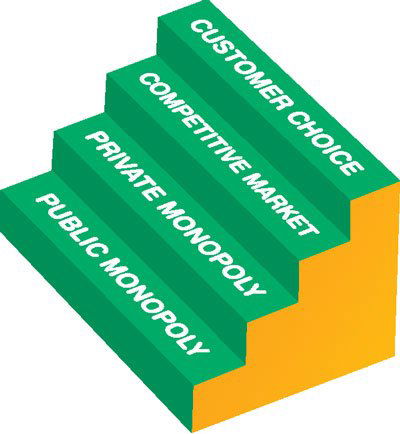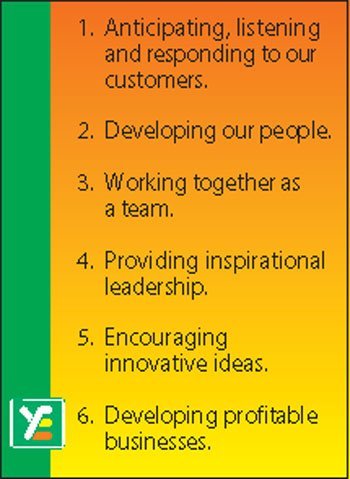
Over recent years many changes have taken place in traditional service organisations. There have been many reasons for these changes. Some have been brought about by increasing customer choice, different consumption patterns, better lifestyles, increasing mobility, the process of privatisation and more competition. Where such changes have taken place there has tended to be an accompanying influence upon consumer expectations. The net effect has been to create a far more knowledgeable and discriminating customer. But, as customers have become more sophisticated, they have also become more vocal. Customers are not willing to accept an inefficient service and where competition is introduced they always have the option to change their supplier.
Providing a good service and phone support involves meeting the expectations of your customers. This does not just involve the selling or supply process but includes every point of contact between an organisation and each and every customer. Developing total relationships and providing good customer service is not easy for any organisation. Customer service initiatives should not be here today and gone tomorrow, but must be part of a continuous and improving process designed to distinguish one organisation from its competitors. Such changes must also begin at the top and involve everyone – whatever their role, if they are to provide long-term benefits.
This case study focuses upon service quality by illustrating how one organisation – Yorkshire Electricity – in a fundamentally reorganised electricity industry, has developed a customer service strategy to redefine the way it looks after its customers.
The changing face of the industry

The publicly owned, co-ordinated electricity supply industry was first created in 1948. In each region of the country an area electricity board was introduced to be a retailer of electricity, taking supply at reduced voltage from the main grid and reducing it still further to distribute electricity to the customer. At this time in the Yorkshire region the Yorkshire Electricity Board (YEB) was formed out of fifty previous suppliers of electricity, including the large private Yorkshire Electric Power Company.
In the 1950s, the Central Electricity Generating Board (CEGB) took responsibility for the generation of electricity and the nationwide transmission of power through the main grid system.
In 1988, a Government white paper proposing the privatisation of the Electricity Industry in England and Wales was published. The white paper recommended that the introduction of competition into the industry would be in the best interests of customers.
In 1989, the Electricity Act made these proposals law and Yorkshire Electricity Group Plc was incorporated as the successor to the Yorkshire Electricity Board as part of the privatisation process.
Yorkshire Electricity was one of 12 former Area Electricity Boards to become Regional Electricity Companies (RECs) at the time of privatisation. Although some of the RECs now form subsidiary companies in larger organisations, by virtue of their Public Electricity Supply licence, each REC is responsible for the operation of its local distribution network and is obliged to meet reasonable requests for electricity from customers within its area.
In this newly organised industry the generation of electricity (power stations) was split from the transmission system (National Grid) and the supply and distribution (RECs). Regional Electricity Companies purchase electricity from the generators who supply electricity through the National Grid. The Electricity Pool of England and Wales is the mechanism that allows trading between generators and suppliers. Generators sell their output under special ‘pool’ arrangements, which establish ‘spot’ electricity trading prices on a half hourly basis.
Increasing competition

Since 1994, all customers nationally with an electrical demand over 100kW (some 50,000 in total) can choose their electricity supplier. Suppliers may include the generators as well as the Regional Electricity Companies. Yorkshire Electricity has been active in this competitive market and has been successful in winning contracts to supply customers throughout England and Wales.
In 1998 this choice will be extended to the rest of the market – which includes domestic customers – who will for the first time have a choice. This is the largest operational change ever made to the electricity industry.
Regulation and standards
At the time of privatisation, the Office of Electricity Regulation (OFFER) was set up as an independent statutory body to regulate the electricity industry and to protect customers’ interests by controlling prices and setting customer service standards in monopoly areas. OFFER has set customer service standards for each of the Regional Electricity Companies. These comprise:
- Guaranteed Standards – which must be achieved on every occasion.
- Overall Standards – which set targets for levels of performance.
Yorkshire Electricity’s aim has been to bring electricity into the home, office or factory safely and at the right price, whilst providing a service which rates as one of the best when compared with other Regional Electricity Companies. Since privatisation, Yorkshire Electricity has achieved significant benefits from the drive to reduce the cost base of the company. Although it has been one of the top performing electricity companies and has continuously sought to develop performance over and above OFFERs standards, there has been growing concern that the results have been achieved without paying necessary attention to the customers of Yorkshire Electricity, the levels of service being provided and the overall level of customer satisfaction.
The external environment

The opening up of competition in the domestic electricity market will increase the number of competitive customers nationally from 50,000 to over 23 million and produce a major change in the relationship between Yorkshire Electricity and its existing customers. With the advent of choice, customers will not be prepared to accept poor quality service and will be able to change if they feel that they are not being treated fairly. Equally, Yorkshire Electricity will be able to seek out customers beyond its traditional boundaries.
Although Yorkshire Electricity needs to continue to strive for further business efficiencies across all its activities, it also needs to ensure it retains existing customers and wins new ones in the new competitive market place post 1998. According to the management gurus Drucker and Levitt, the purpose of every business is to create and keep a customer. It also costs much more to attract a new customer than to keep an established one. The key to success in this competitive market-place will be for Yorkshire Electricity to differentiate from the competition with superior customer service and at the same time provide a product at an acceptable price. To do this, Yorkshire Electricity has put into place its Customer Service Initiative.
Starting at the top
It was recognised immediately that for an organisation as large as Yorkshire Electricity to significantly improve customer service, the whole organisation would have to change and that this degree of change would only happen if the leaders of the organisation led the change and were seen to be supportive of it and the need for it. From the beginning, it was emphasised that this would not be a ‘banner waving’ exercise and that improving levels of customer service would also improve all aspects of Yorkshire Electricity’s operations. The reasons for change and the motivations for improving customer service were discussed at Board level and involved the personal commitment of all the senior executives of Yorkshire Electricity to the programme of change. To include everyone at Yorkshire Electricity in the process of change, the Customer Service Initiative has involved careful preparation and planning through three distinct phases.
Challenges and objectives
Most of the work in phase one involved the Directors of the company deciding how good it needed and wanted to be at delivering customer service, i.e. its ‘Ambition.’ They also assessed current levels of service, in all its aspects, so that the level of improvement required could be measured and targeted for the future. From the very start it was important for those at Yorkshire Electricity to recognise what is meant by customer service. Yorkshire Electricity defines customer service as:
‘The products and service that Yorkshire Electricity provides at each point of contact with its customers and the standard to which these are delivered.’
This definition recognises that the whole of Yorkshire Electricity is involved in the delivery of customer service, not just the Customer Service Department and those involved in ‘front-line’ operations. In developing this definition, the concept of ‘Moments of Truth’ has been used. Put simply, it means that every time someone from Yorkshire Electricity comes into contact with a customer, whether it is on a telephone, face-to-face or by letter, the customer will form either a positive or negative judgement on the quality of the Company. The aim is to make all these contacts positive.

There were several reasons for undertaking the customer service initiative. Yorkshire Electricity’s stated business strategy is to retain and grow its customer base. It is considered that in 1998, when the domestic electricity market is open to competition, that customer service will be a crucial element in the minds of customers and will influence their choice of suppliers.
Another reason for the Customer Service Initiative is that poor customer service is expensive. A recent exercise has shown that it costs Yorkshire Electricity at least £3 million each year to deal with unnecessary queries and complaints, compensation to customers for poor service and having to do jobs again.
The quality of customer service also affects an organisation’s image. The image of many privatised organisations has been affected by coverage in the media. Customer service is an important element in helping to improve perceptions not just of customers but also employees who want to be seen to be part of an organisation which provides good customer service.
Phase 2 – Developing the solutions
A vital part of customer service is to listen to what customers actually want. Yorkshire Electricity appointed a research company to find out what customers thought of Yorkshire Electricity and to find out more about their needs and expectations. The first part of the project involved holding group discussions with domestic customers and face-to-face interviews with a range of business customers. These identified service issues which were then used in the design of a questionnaire used in several hundred face to face interviews with customers, asking them for their comments upon service and in which areas they would first like to see an improvement. This helped to identify areas of customer service requiring most attention. This research identified not only these priority improvement areas, but current and expected standards of performance for each.
Accurately measuring current standards
Of course, it is not enough to say that customer service will be improved unless current standards are known and understood. Yorkshire Electricity, therefore, set up a project to measure the standards of customer service it provides across the whole organisation. For example, a Telephone Response Team was established to monitor how telephone calls were handled at all locations. This work showed that there was significant room for improvement.
Defining new standards
Once current standards were known and the views of customers had been identified, it was possible for Yorkshire Electricity to define new standards. These new standards then became the targets that the company worked towards and plans were developed to ensure that Yorkshire Electricity could achieve these standards. In setting these standards, Yorkshire Electricity looked not only at what customers wanted, but also at the standards achieved by other electricity companies and related utility industries.
Involving all staff
All 4,000 staff in Yorkshire Electricity contribute in some way to customer service, not only those who answer telephones, respond to letters, send out bills or read meters on customers’ premises. Staff are the employees who deliver the customer service improvements and even those who do not deal directly with customers will indirectly, by their actions and through their efficiency, be contributing to customer perceptions of the organisation.
Values

A survey of the views of all employees was also undertaken to collect their thoughts on customer service. It also sought views on how staff felt about working for Yorkshire Electricity. This helped the Directors develop a series of ‘Values and Behaviours’ statements, which would be used to describe how everyone should work to help improve customer service in the future. In particular, it set out the six key success factors critical to achieving Yorkshire Electricity’s mission. These are:
Training and developing people to provide customer service. Yorkshire Electricity then organised a series of Customer Awareness Events to explain its mission and objectives to all staff and to seek their views as to how it could help improve customer service. These were organised as cross-functional events to discuss the overall objectives for the company, but smaller events involving work teams will help to focus more directly on the ways in which individuals and their workgroups can help to improve performance.
Yorkshire Electricity recognised that to ask staff to deliver better customer services without offering help to staff dealing with customers would not produce results. Training courses were arranged across a range of areas focusing upon the skills that really make a difference to delivering the best service for customers. This training covers not only people skills in the management of teams, but also includes core skills such as letter-writing and telephone answering, designed to ensure a very consistent approach when dealing with customers.
Phase 3 – Achieving the benefits

Having asked customers what they want, measured current standards and set targets for new standards of customer service, Yorkshire Electricity then started to look at key areas that customers identified as needing improvement and set in motion plans for improvement. These so called ‘workstreams’ included the development of customer skills training courses for over 300 managers and designing and implementing more customer focused business processes.
Implementation – this is a crucial phase which has a long time yet to run. It will bring together all the months of careful planning, research and development needed to deliver the improved levels of service. However, ‘quick wins’ do occur, such as a greater awareness of all staff of the need to handle customers positively and listen carefully to what they say and want. In the area of customer service some improvements do not happen overnight and it may be some time before Yorkshire Electricity sees the results of some of the background work that has taken place.
Conclusion
It is however important that Yorkshire Electricity sustains its commitment to customer service to ensure the successful implementation of the Customer Service Initiative. The whole process has been to learn how to deliver better service to all customers which is essential if Yorkshire Electricity is to retain existing and win new customers in 1998. Yorkshire Electricity’s mission within five years is: At the heart of this mission is the need to view customer service as an ongoing process which is capable of delivering real benefits for customers.
